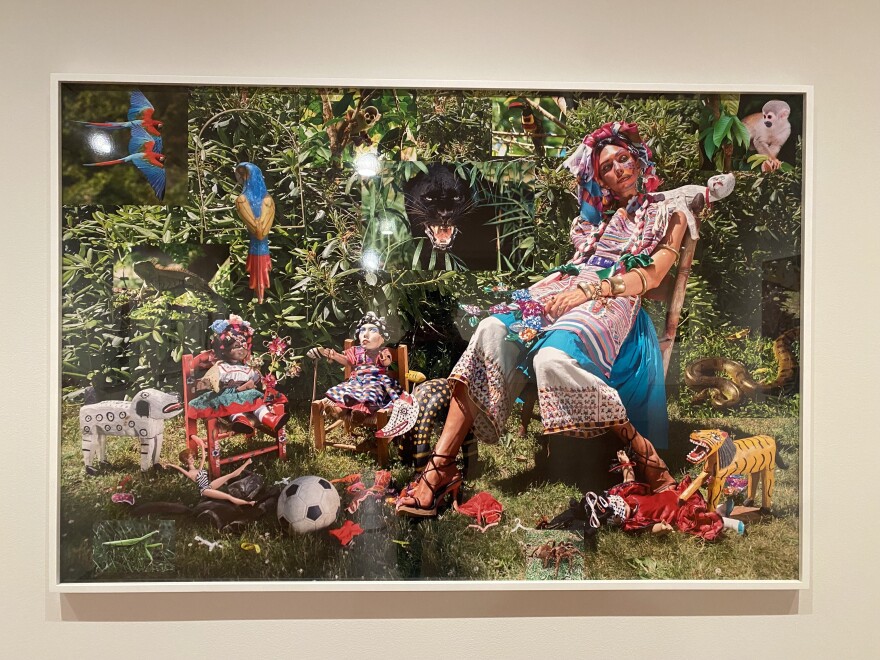An exhibition at the Milwaukee Art Museum features the works of international Indigenous artists who explore Indigenous history, culture and representation through a contemporary lens.
It’s called Native America: In Translation, curated by Wendy Red Star, organized by Aperture, and took three years to make.
The exhibition highlights 10 featured artists’ perspectives on community, identity, heritage and the legacy of colonialism on the American continents.
"The exhibition in my mind starts with this work by Marianne Nicolson. It’s a really large photograph; it’s on the wall at the bottom of the stairs as you come into the gallery space," says Ariel Pate, the assistant curator of photography.
Paul Smith with the museum’s Native Initiatives Advisory Group for a tour.
Pate continued, "And it shows a cliff in sort of beautiful natural area, and there’s a really prominent painting on the face of the cliff."

The image is 30-feet wide and 28-feet-tall and was originally painted in 1998.
"It’s located in Kingcome Inlet, which is in what we call British Columbia, but which is actually the ancestral homeland of the Dzawada’enuxw Nation. Marianne Nicolson is of that nation and this work really welcomes people into that territory of the Dzawada’enuxw people and lets them know that the Dzawada’enuxw people are there today," says Pate.
Native America: In Translation is on display in the Herzfeld Center for Photography and Media Arts, on the lower level of the Milwaukee Art Museum.
I followed Pate and Smith’s lead wherever they wanted to take me along the tour.
Next was a series of six photos by Alan Michelson. Paul Smith, with the museum’s Native Initiatives Advisory Group for a tour, has a personal connection to the images. He says they struck him.

"Being from the Oneida Nation, we are not sovereign to Wisconsin; we're from New York and people don't know our story a lot of times and how we ended up here in Wisconsin," he says.
"People often don't know that the Iroquois Nation, which the Oneida nation is a part of the Haudenosaunee Confederacy, that we [Oneida] were the United States' first military ally. And that allyship between the Oneida and the United States broke up our confederacy. The other nations in the confederacy sided with the British," Smith explains. "The Oneida were the only one of the confederacy to side with the Americans. After the Revolutionary War, the Oneida helped with the victory over the British quite decisively over in upstate New York area, and you can see how that relationship devolved in these pictures."
Smith says the images show in sequence, "From being Upstate New York, to signs celebrating the Army destroying our villages, and the movement, and the fire, the treaties broken and then our Wampum belt."
Pate describes the painting at its significance. "So, it's a work that's six panels, and each of them a different image is projected onto a bust of George Washington," Pate says. "Sort of taking this, you know, figure from American history and projecting historical documents on it that reflect this really tortured relationship between the Iroquois Nation and America."
Both Pate and Smith say not enough people in Wisconsin know this history.
Further inside the gallery there is a room full of photos by Martine Gutierrez.
The images are from a fashion magazine she created in 2018 called Indigenous Woman.

"It's big. It's really colorful. The cover looks just like Andy Warhol's interview. There's a lot of like really glamorous images in it and Martine made this because she felt that as a trans Latinx woman no one was going to put her on the cover of a Paris fashion magazine, so she needed to make her own," says Pate.
Pate says in each of the photos, Gutierrez is the model, the stylist, the photographer and the editor.
"And also a woman of Indigenous descent and sort of thinking about how we think about Indigeneity as authenticity. And you know as a trans woman she really works hard to have people acknowledge her as who her identity is and have people take her for who she is," says Pate.
Pate and Smith agree that this exhibit is historic.
It showcases Indigenous people in media in a contemporary fashion from Indigenous perspectives, versus as just historic figures. And they hope Native audiences who see the show feel welcome to the museum.
Native America: In Translation is on display until June 25.
_






